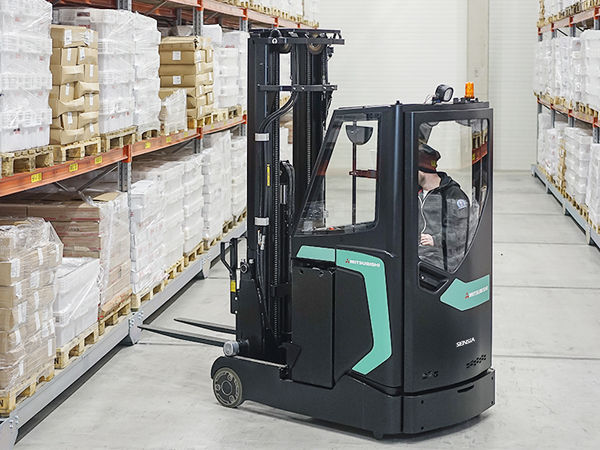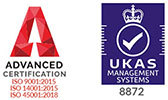A reach truck and a forklift look very much the same, but when it comes to their capabilities and properties, they’re actually very different. In this article, we’re going to discuss what each piece of equipment is and how they differ when in a warehouse setting.
What is a reach truck?
A reach truck is designed and manufactured with a mechanism that allows the forks to extend horizontally but can reach loads that are stored on particularly high warehouse shelving and racking, reaching heights that a conventional forklift cannot. Often, warehouse owners used reach trucks and forklifts in combination with each other as they can increase storage density as well as move loads in good time.
What are the different types of reach truck?
You might have thought that there was only really one type of reach truck available, because its abilities seem to be limited to just one thing – reaching. But you might be surprised to learn that there are actually a few different types of reach trucks, include, but not limited to, the following:
- Single-reach trucks – the most common type of reach truck on the market as it can only handle a single load at once, making them ideal for single-deep pallet storage
- Double-reach trucks – can reach two pallet positions and place them into the racking required, helping to increase warehouse storage density when needed
- Moving mast trucks – the mast on this reach reach moves forwards and backwards on rails, made possible by a hydraulic system installed above the base legs
- Multi-directional trucks – a combination of a single-reach truck and a moving mast reach truck, but it’s perfect for handling wide loads and for work on narrow aisles
What is a counterbalance forklift?
A counterbalance forklift has two forks at the front but can drive right up to a load in order to pick it up. This allows for optimum accuracy when you need it most. The name comes from the fact that the vehicle comes with a counterweight towards the back of it, allowing it to pick up even the heaviest of weights with ease and without the vehicle from tipping over. They’re versatile, meaning they can be used indoors and outside, across smooth and rough surfaces. Counterbalance forklifts are also available in a range of fuel types, including electric, diesel and LPG.
What is the difference between a reach truck & a counterbalance forklift?
Now you know what each piece of equipment is, it’s time to discuss the differences between the two machines. A reach truck will be perfect for one job but not for another, and vice-a-versa, so where do their strengths and weaknesses lie and when should you use one over the other?
Reach trucks can extend to greater heights
Reach trucks can reach heights that a typical forklift cannot, which is why so many warehouse owners find them to be a useful and invaluable piece of material handling equipment. If you find that your forklift cannot reach the top shelf of your warehouse racking, then you can bet that a reach truck will.
Loads are balanced safely & more evenly with counterbalance forklifts
As the name would suggest, a counterbalance forklift is able to carry and transport even the heaviest of loads thanks to the way in which their balances are configured. The forklift is designed to counter the weight of the load, limiting the chances of the forklift tipping over, which also creates a safer workplace environment for, not only your forklift operators, but the employees on the ground.
Counterbalance forklifts are multi-purpose
Counterbalance forklifts can be used in a wide range of different settings in comparison to a reach truck. This is because counterbalance forklifts are available in a variety of different sizes and fuel types, meaning they can be used either indoors or outside as well as in cold storage settings.
They’re also designed with comfort in mind, so the driver can comfortably operate the vehicle for long periods of time, allowing you to get the job done in a timely-yet-efficient manner.
Reach trucks, however, are only available in one fuel type, usually, and so they’re limited for environments in which they can be used in. They also aren’t recommended for cold storage settings and it’s recommended that you do not use them outside, unless the manufacturer states otherwise.
Counterbalance forklifts are more easily manoeuvrable
Counterbalance forklifts are designed purely with useability and driver comfort in mind. There aren’t many environments or settings where counterbalance forklifts aren’t relied upon to get the job done. A reach truck, on the other hand, isn’t always designed with easy manoeuvrability in mind, especially if you have a more basic model.
Counterbalance forklifts are able to lift considerably heavy loads
Counterbalance forklifts are able to lift and transport weights that reach trucks are not, usually, equipped to deal with. Reach trucks, as the name would suggest, are far more effective at retrieving loads from a height, but stock which is stored that high won’t weigh a considerable amount anyway, hence why they’re trusted with that task. Counterbalance forklifts, however, are able to lift and move loads of a great weight. Before using your forklift for lifting heavy loads, however, you will need to check its lifting capacity as it might vary model-to-model or manufacturer-to-manufacturer.
Reach trucks aren’t available in many different fuel types
Typically, reach trucks are only available in electric fuel types. This confines them to indoor use only and so cannot, or rather should not, be used outside. Counterbalance forklifts, however, are available in diesel, LPG and electric models, meaning they can be utilised in a variety of different settings and environments, including cold storage.
Most reach truck vehicles are stand-up rather than sit-down
Reach trucks are often used to reach heights that forklifts cannot. With this in mind, there’s no reason for an operator to be using the forklift for more than an hour at most, so the sit-down design isn’t something that’s necessarily needed with a reach truck. A counterbalance forklift, however, will almost always provide a seat for the driver to sit in so as to ensure they’re as comfortable as possible whilst carrying out even the lengthiest of tasks.
Counterbalance forklifts have a similar control panel to a conventional car
The dashboard and the controls themselves are very similar, and have a familiar layout, to that which would be found in the average car. A reach truck, on the other hand, will have controls that are slightly different and not that easily recognisable, unless you’ve received the right training to be able to operate one safely. A reach truck will often consist of a deadman pedal, a joystick and a steering wheel, whereas the controls in a counterbalance forklift will be more complex but simple to operate.
Multy Lift has over three decades of experience in the material handling industry. Providing customers throughout the UK with high-quality warehouse machinery that’ll stand the test of time, you’ll always be able to count on us to supply you with new and used warehouse equipment, including forklifts, reach trucks, order pickers, pallet trucks and more, that are in top condition and will stand the test of time. For more information about how we can help you today, get in touch with a member of your expert team today – we’re always pleased to hear from you.






